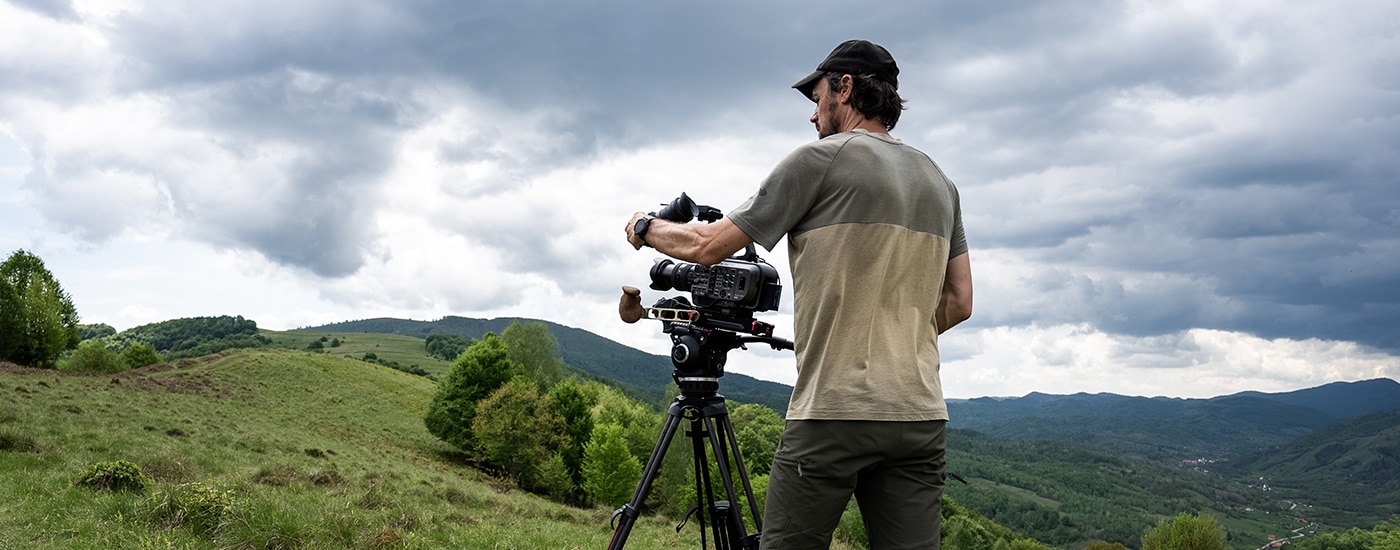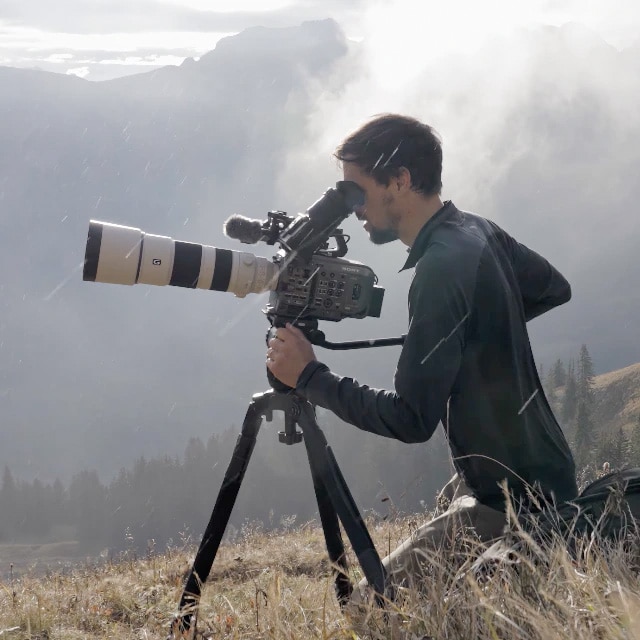
Working in the wild with FX9
Sony Ambassador Mathieu Le Lay recently shared some interesting insights into his use of FX9 during a webinar. While many questions were answered during the event, there were some questions that couldn’t be answered due to time constraints.
To help answer those questions and fill in some gaps, Alister Chapman spent some time chatting to Mathieu about his work and the equipment he uses.

“In the middle of nowhere”
Based in the French Alps, Mathieu has long been passionate about wildlife and the natural world. After obtaining a degree in wildlife conservation he decided to combine his passion for film making with his interest in ecology by studying at the IFFCAM wildlife film school that is as Mathieu describes – “in central France, in the middle of nowhere”.
After this Mathieu started to write scripts for wildlife programs. His main area of interest is the interactions that occur between humans and nature. He particularly enjoys telling the stories of other creatives, such as photographers by following and observing how they interact with and document the natural world.
Once he has a script or an idea, he then spends time knocking on the doors of potential producers or production companies seeking funding for the film. This can be a long and drawn-out process, so Mathieu also works as a camera operator and director on wildlife productions for broadcasters such as ARTE. These projects often take him to remote locations all over the world.
Favourite Lens?
For filmmaking, one of Mathieu’s favourites is the Sony FE 200-600mm G series lens because not only is it a long telephoto lens, it’s also a zoom. While he felt that the faster, larger apertured Sony FE 600mm f4 G-Master is a stunning, amazing quality lens, using a zoom lens to reframe the shot gives him more freedom. So, he almost always uses zoom lenses including the Sony FE 70-200mm and the Sony FE 24-105mm.

What about Autofocus?
When he studied film making at IFFCAM, Mathieu was taught to focus manually. But now that Sony’s autofocus has evolved so far – especially with the new touch tracking focus features in the FX9’s V3 firmware – he finds it a really nice tool and uses it most of the time, especially when following moving wildlife such as birds. Mathieu is always looking for new or improved technologies that can make his life as a film maker easier.
Mixing the A7SIII and FX9 on the same project
When Mathieu shoots with his FX9, he only ever shoots using S-Log3 as this allows him to capture the greatest range of details and textures. When he uses the A7SIII on the same project he sets the A7SIII to Picture Profile 8 as this selects the same S-Log3 gamma curve and S-Gamut3.cine colourspace as the FX9. To help ensure that the S-Log3 he shoots with the A7SIII is never accidently under exposed, he adds a +1 stop offset to the cameras built in exposure compensation settings (this is found in the menu under [Exposure/Color] > [Exposure Comp] or exposes so the exposure metering indicator (M.M.) indicates +1.
Black And White Big Cats
For his recent film ‘Black And White Big Cats’, a portrait of photographer Laurent Baheux, he worked with a colourist to really push his footage to its limits, pulling out the greatest possible contrast without degrading the image. The only thing he really changed while shooting was to try to match the vision of the photographer, to understand Laurent’s way of working, to match his use of light and the camera. But other than that, Mathieu didn’t expose or shoot ‘Black And white Big Cats’ any differently to the way he normally shoots.
What about Frame Rates?
When shooting with the FX9, Mathieu normally shoots 4K at 25 frames per second or 50 frames per second if a slow motion effect is intended. If he needs to shoot faster than this, then he uses the A7SIII to shoot at 100 fps and he likes the way these two cameras complement each other.

Loving the Variable ND
The FX9’s built in variable ND filter is one of Mathieu’s favourite features. He finds that the ND filter control wheel gives him very smooth and precises exposure control. When using the A7SIII he often needs to add an external ND filter and his preference for this is a PolarPro variable ND.
Which Scan Modes?
Most of the time Mathieu uses the uses the FX9’s Super 35mm 4K scan mode as this gives a slightly greater magnification factor than the Full Frame 6K or Full Frame Crop 5K scan modes, allowing him to get tighter shots of the animals he films. But sometimes when he needs to get a really tight shot of a distant animal, he might use the FX9’s Super 16mm 2K scan mode as the equivalent of an electronic extender. Many of the productions he works on are delivered in HD, so the use of the 2K scan mode does not cause any problems and the S16 2K scan mode magnifies the image by a factor of 3 compared to the Full Frame 6K scan mode.
In post-production Mathieu likes to add a tiny bit of sharpening to the S16 2K scan footage to help make it seamlessly match material shot using the S35 4K scan mode. For landscapes, panoramas or interviews he uses the Full Frame 6K scan mode. While he doesn’t like reframing shots in post-production, he did comment that he felt the slightly higher quality of the 6K scan mode give him a little more flexibility if he does need to adjust a shot in post-production.
What’s in Mathieu’s kit bag?
Mathieu’s first response was – a good tripod. That might be a big tripod with a heavy tripod head when you are using a long lens or trying to follow distant animals. Or it might be a very small and lightweight tripod for when you are out in the wilderness.
As he likes to spend many nights outside in the wilderness, he will often have a tent, a sleeping bag and a GPS device so he can find his tent in a blizzard or snow storm.
Good boots, gloves and other clothing are essential to stay warm as if you are cold or uncomfortable you won’t perform as well as you can when you are more comfortable. A good stove allows you to boil water or melt snow if you are thirsty, cook food when you need to eat and helps you survive in remote places.
Sleeping with his batteries!
For batteries, Mathieu likes to take plenty and then when it is cold at night he sleeps with them in his sleeping bag. When filming in the cold he keeps them inside his jacket to keep them warm as warm battery will last much longer than a very cold battery. That’s a really great tip and it’s something I also do when working in the cold.
I’d like to thank Mathieu for taking the time to talk to me and answer my questions and I wish him every success in his wildlife film making adventures.



